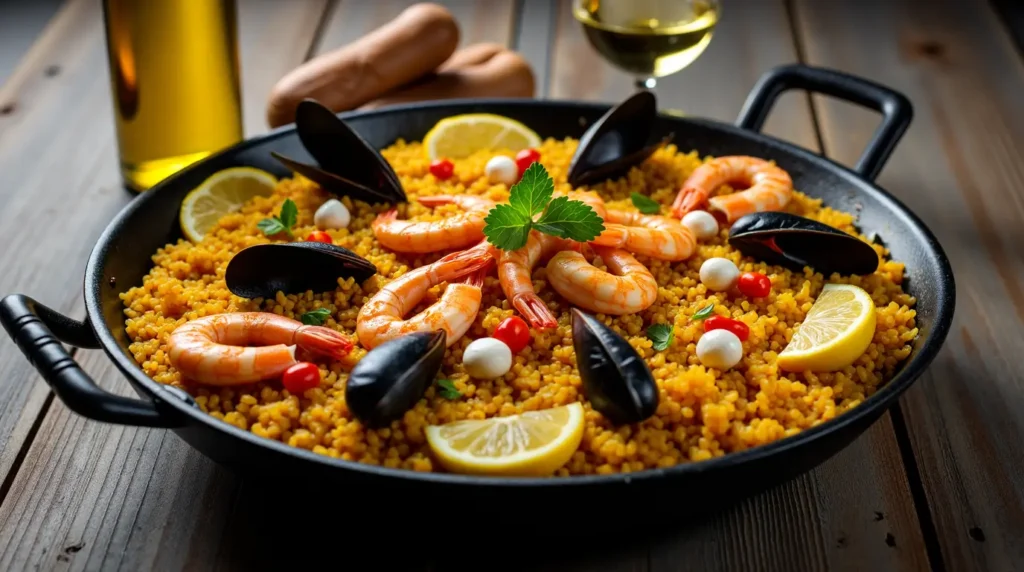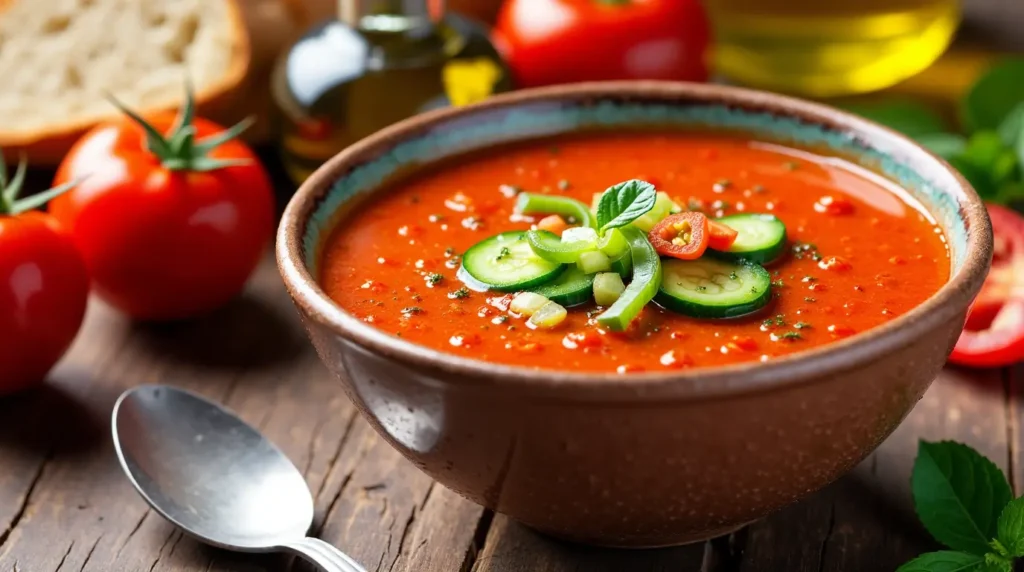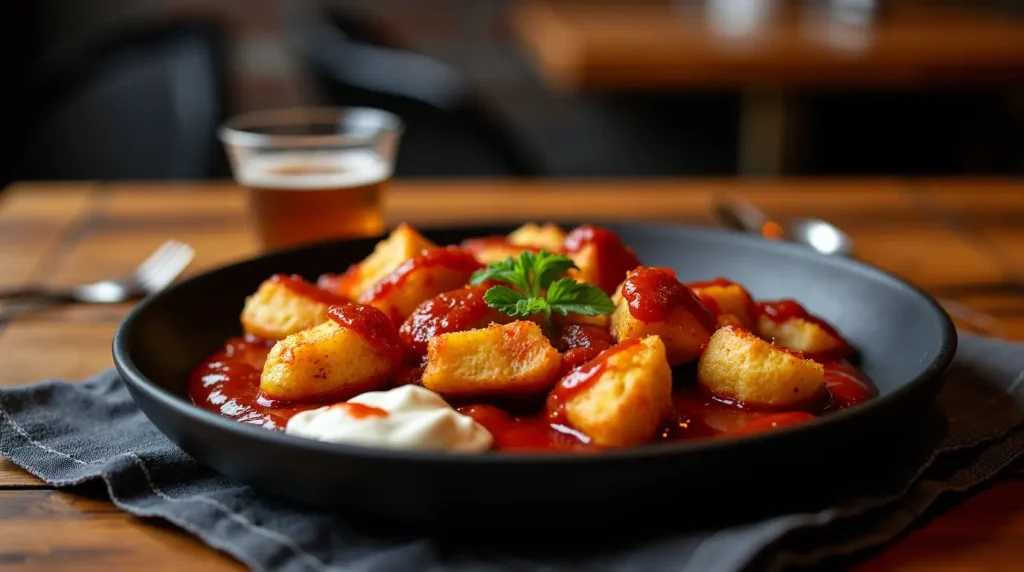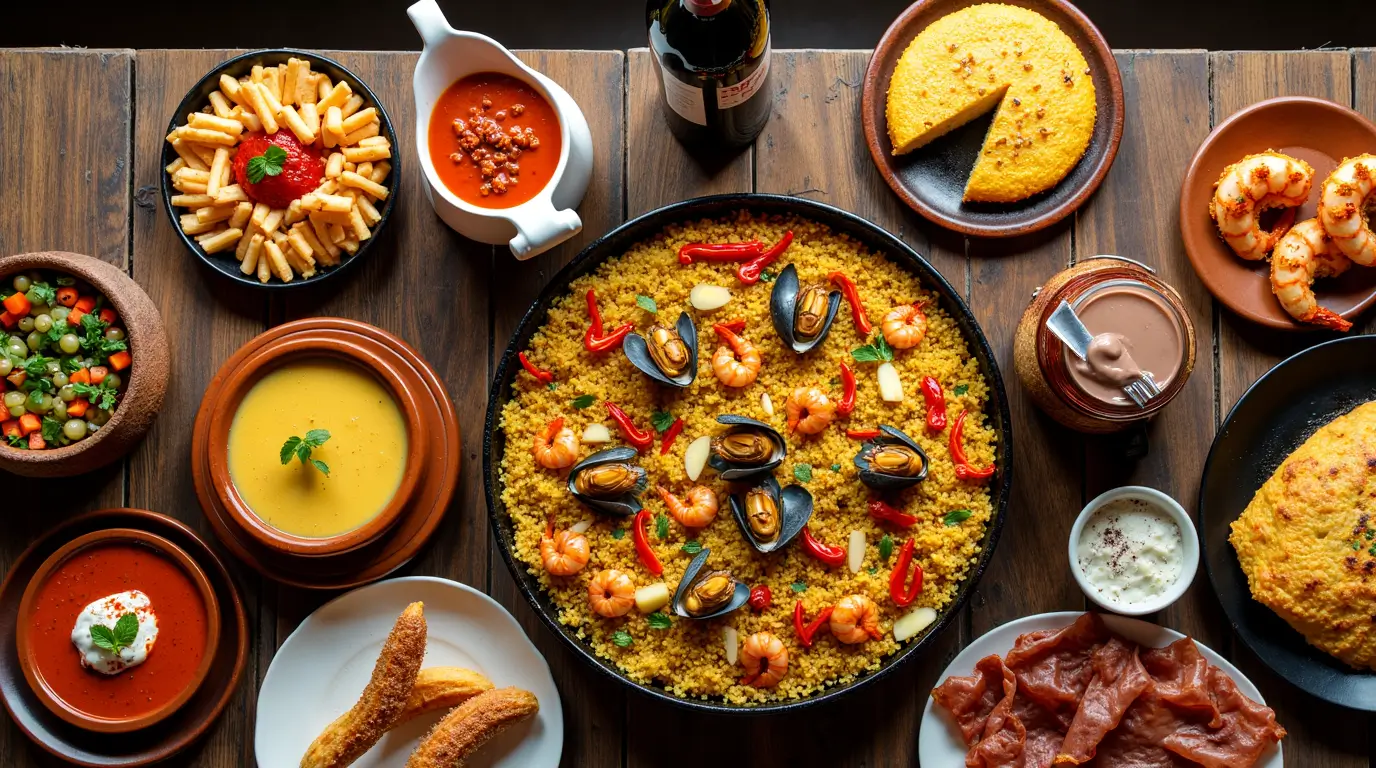Table of Contents
Introduction
Spain, a country with a rich cultural heritage and varied landscapes, is renowned across the globe for its vibrant cuisine. From the crystal-blue waters of the Mediterranean to the lush green mountains in the north, Spain’s culinary tapestry has been shaped by centuries of history, cultural mixing, and geographical contrasts. Travelers who visit the country often marvel at the variety of flavors, colors, and cooking techniques that define Spanish gastronomy. Whether you’re strolling through a bustling local market in Barcelona or experiencing the rustic charm of a family-run restaurant in a remote Andalusian village, you quickly realize there is no single “Spanish cuisine” but rather a mosaic of regional specialties and time-honored traditions.
At the heart of Spanish cooking is a commitment to quality ingredients and a convivial spirit that brings people together around the table. Simple preparations allow fresh, local produce to shine, while recipes often reflect the land and sea that surround each region. Over the centuries, Spanish cooking has incorporated culinary ideas from the Romans, Arabs, Jews, and indigenous Iberian peoples, blending flavors and techniques in ways that have led to an abundant treasure trove of dishes. Each mouthful tells a story of tradition, innovation, and cultural exchange.
In this article, we will delve into all facets of Spanish gastronomy. We’ll begin by exploring its historical evolution—how the movements of people, colonization, and trade links to the New World enriched Spain’s culinary repertoire. Next, we will examine the key ingredients and products that serve as the backbone of many Spanish meals, followed by a closer look at the nation’s must-try dishes. We’ll then discuss the defining characteristics of Spanish cuisine and offer tips that will inspire you to sample its incredible range of flavors. Along the way, we’ll explore table rituals and customs, modern trends, and the inventive twists that young chefs bring to the table today. By the end, you’ll not only have a deeper appreciation for Spanish food, but you’ll also be ready to embark on your own gastronomic adventure—whether that’s in your kitchen or on the lively streets of Madrid and beyond.
Culinary Context and History of Spanish cuisine
Spanish cuisine has evolved over centuries of cultural interactions, conquests, and resource-driven adaptations. The foundations of Iberian cooking trace back to the diets of early settlers, including the Celts, Phoenicians, and Romans. The Romans introduced advanced agricultural techniques and roads that facilitated trade, allowing ingredients like olive oil, wine, and wheat to become staples. The Roman legacy is still evident in Spain’s love for olive oil (aceite de oliva) and bread (pan) as daily essentials.
However, it was the Moorish occupation (711–1492) that had one of the most profound impacts on the culinary landscape. The Moors introduced irrigation systems that revolutionized agriculture, paving the way for the cultivation of rice, citrus fruits, and a variety of spices such as saffron. Many iconic Spanish dishes—like paella—reflect these Arab influences. The Muslim, Jewish, and Christian communities coexisted for centuries, creating a melting pot of flavors in Andalusia, where culinary heritage remains deeply rooted in the use of fragrant spices, honey, almonds, and dried fruits.
Following the Reconquista (the Christian retaking of Spain), the country entered an era of global exploration. Christopher Columbus’s voyages opened up trade routes to the Americas, ushering in a torrent of new ingredients. Tomatoes, potatoes, peppers, and chocolate crossed the Atlantic to profoundly alter European cuisine, with Spain playing a pivotal role in introducing these products to the continent. These once-exotic ingredients quickly became entrenched in local cooking. Today, it’s nearly impossible to imagine Spanish cuisine without tomatoes or peppers—both instrumental in dishes like sofrito, a sautéed base that infuses flavor into stews, sauces, and soups.
Regional distinctions are paramount in Spain. In the north, Galicia and the Basque Country rely heavily on seafood from the Atlantic, coupled with hearty stews that reflect a cooler climate. Catalonia in the east boasts a Mediterranean diet rich in fresh vegetables, seafood, and olive oil, often complemented by complex sauces like romesco or picada. The interior regions, including Castile and Extremadura, focus on roasted meats, cheeses, and robust stews, indicative of their pastoral traditions and harsher winters. Andalusia, in the south, has a cuisine strongly influenced by Moorish heritage, featuring abundant use of spices, fried dishes (like pescaíto frito), and cold soups such as gazpacho—perfect for the scorching summer days.
Through all these influences—Roman, Moorish, Jewish, Christian, and New World—Spanish gastronomy formed a unique identity that celebrates both regional character and national pride. The result is a cuisine that seamlessly blends historic traditions with modern tastes, standing as one of the most diverse and storied gastronomies in the world.
Key Ingredients and Local Products
Spain’s culinary diversity hinges on a core set of high-quality ingredients and an appreciation for fresh, seasonal produce. Below are some emblematic items you’ll find in kitchens across the country:
- Olive Oil (Aceite de Oliva): Often considered “liquid gold,” Spanish olive oil is ubiquitous. Regions like Andalusia and Catalonia produce some of the finest oils, each with distinct flavor profiles. Used for sautéing, frying, or as a simple dressing, olive oil is the base of countless Spanish recipes.
- Paprika (Pimentón): Derived from the peppers introduced after the Columbian exchange, pimentón is available in sweet (dulce), bittersweet (agridulce), and hot (picante) varieties. It imparts the distinctive smoky depth that characterizes dishes like chorizo sausage or pulpo a la gallega (Galician-style octopus).
- Saffron: Spain is among the world’s largest saffron producers, particularly in Castile-La Mancha. This aromatic spice, prized for its bright color and subtle floral notes, is essential to classic recipes like paella.
- Seafood and Fish: With coastlines along the Atlantic Ocean and Mediterranean Sea, Spain boasts an abundance of fresh seafood. Staples include cod (bacalao), hake (merluza), sardines, anchovies, shrimp, mussels, and clams. Regional specialties highlight the local catch, from Galician octopus to the salted cod dishes of the Basque region.
- Jamon Ibérico and Other Cured Meats: Spain’s tradition of curing meats is legendary. Jamón Ibérico, made from black Iberian pigs, is often considered the finest ham in the world. Salchichón (cured sausage) and chorizo (spicy sausage) are also commonplace and anchor many tapas and bocadillo (sandwich) recipes.
- Cheeses: Spain has a dizzying variety of cheeses, including Manchego (made from sheep’s milk in La Mancha) and the blue Cabrales cheese from Asturias. Each region boasts its own specialties, reflecting local landscapes and dairy traditions.
- Seasonal Vegetables and Fruits: Thanks to a varied climate, Spain produces an array of fresh produce all year round. Artichokes, asparagus, peppers, tomatoes, eggplants, and olives star in spring and summer dishes, while mushrooms, chestnuts, and root vegetables appear in cooler months.
- Rice and Legumes: Rice, especially the short-grain bomba variety, is cultivated in regions like Valencia, forming the basis of paellas and other rice dishes. Beans, lentils, and chickpeas also feature prominently in hearty stews such as fabada asturiana or cocido madrileño.
To recreate Spanish dishes at home, searching for specialty stores that carry imported Iberian products or visiting well-stocked local markets is key. Farmer’s markets often carry fresh produce ideal for Spanish recipes, and many global grocery chains now stock items like Spanish olive oil, pimentón, and Manchego cheese. As seasonality remains crucial in Spanish cuisine, try to buy fruits and vegetables in their peak months for the most authentic flavor experience.
Must-Try Traditional Dishes
Spanish cuisine offers countless iconic dishes, many of which have crossed borders and become beloved worldwide. Here are some must-try classics and tips on how to prepare them:
Paella:

Originating in the Valencia region, paella is arguably the most famous Spanish dish. The traditional version includes rabbit, chicken, beans, and saffron-infused rice. Seafood paella, featuring mussels, shrimp, and squid, is equally popular. A key element is the socarrat—the crispy layer of rice at the bottom of the paella pan, achieved by carefully controlling heat and allowing the rice to caramelize.
Simplified Recipe Tip: Sauté chopped onions, tomatoes, and peppers in olive oil, then add short-grain rice, saffron, and your choice of protein (chicken and seafood are common). Pour in a flavorful stock, simmer until the liquid is absorbed, and resist stirring too much to allow for a golden socarrat.
Tortilla Española (Spanish Omelet):

A staple in bars and households, this simple yet satisfying dish is made with eggs, potatoes, and onions—though some purists argue about adding onions. The tortilla can be enjoyed hot or cold and is served at any time of the day.
Simplified Recipe Tip: Slice potatoes and onions thinly, then sauté them in olive oil until soft. Drain excess oil, mix with beaten eggs, and cook in a non-stick pan. Once the bottom sets, flip carefully or use a plate to invert the tortilla and cook the other side.
Gazpacho:

Ideal for hot summers, gazpacho is a chilled soup primarily made from ripe tomatoes, cucumber, bell peppers, garlic, olive oil, and vinegar. The flavor is fresh and tangy, providing a perfect respite from the heat.
Regional Variation: In Andalusia, salmorejo is a thicker variant, enriched with bread crumbs and often garnished with jamón and hard-boiled egg.
Patatas Bravas:

A popular tapa found in many bars, patatas bravas are crispy fried potatoes typically served with a spicy tomato sauce or aioli (garlic mayonnaise). The degree of spiciness varies by region and personal preference.
Churros con Chocolate:

Although more of a breakfast or snack, churros with thick, rich hot chocolate is an experience not to be missed. The fried dough is piped into hot oil, then coated with sugar and served with a cup of chocolate so dense, you can almost stand a spoon in it.
These dishes represent just a fraction of Spain’s culinary repertoire. Their histories span centuries, reflecting cultural exchange and local adaptation. Many recipes include variations that mirror regional tastes—such as the way seafood is emphasized along the coasts, while inland areas might rely more on meats and cured products. Whether you choose the saffron-scented aroma of paella or the comforting texture of tortilla, you’ll discover that Spanish cooking balances simple ingredients with bold flavors in a way that fascinates food lovers worldwide.
Defining Characteristics of Spanish Cuisine
Spanish cuisine can be described as both rustic and refined, balancing simplicity and sophistication in its approach to flavor. One of the defining features is its reliance on high-quality, locally sourced ingredients. Traditional Spanish cooking is not typically heavy on spices in the way some other cuisines might be. Instead, it relies on a few key seasonings—olive oil, garlic, parsley, and paprika—to bring out the best in fresh produce, meats, and seafood.
Another hallmark is the skillful use of contrasting flavors and textures. Dishes often combine the sweetness of roasted peppers with the salty tang of cured meats. The smoky flavor of pimentón may be counterbalanced by the zesty freshness of chopped herbs. In many cases, Spaniards celebrate the natural essence of ingredients by cooking them slowly, allowing flavors to meld without overpowering the palate.
In terms of taste profiles, Spanish cooking can be described as rich and savory, occasionally punctuated by sweet or spicy notes. While not typically considered “spicy” on a global scale, there are a few regions—such as parts of Extremadura—where picante peppers are more common. However, the heat level in most dishes remains moderate and approachable. Salt content can be significant, especially in the context of salted fish or jamón, but balanced preparations keep dishes from tasting overly salty.
Some iconic seasoning combinations include:
- Sofrito: A base of onions, peppers, garlic, and tomatoes, gently sautéed in olive oil to form a flavor-packed foundation for stews, sauces, and rice dishes.
- Alioli: A garlic-and-oil emulsion (similar to mayonnaise) that highlights the intense flavor of garlic.
- Picada: A Catalan blend of nuts (like almonds), herbs, and sometimes bread crumbs, added at the end of cooking to thicken and enrich dishes.
For food enthusiasts, Spanish cuisine provides an exploration of quality products, robust yet balanced flavors, and a mosaic of regional expressions. The subtle complexities derived from simple ingredients make it a perennial favorite among those seeking new gastronomic horizons.
Tips and Highlights to Encourage People to Try This Cuisine
One of the most compelling reasons to explore Spanish cuisine is its remarkable variety. No matter where your preferences lie—whether it’s fresh seafood, rustic stews, or creative tapas—there’s a Spanish dish that will capture your imagination. Here are some anecdotes, practical tips, and cultural highlights to inspire you:
- Tapas Culture: Spaniards often dine on small plates, encouraging social interaction as dishes are passed around and shared. This communal style of eating offers a chance to sample many flavors in one sitting. It’s an inviting way for newcomers to get a broad overview of Spanish specialties, from croquetas to pimientos de padrón (blistered green peppers).
- Local Markets: Visiting a traditional Spanish market—like La Boqueria in Barcelona or Mercado de San Miguel in Madrid—can be a revelatory experience. You’ll witness local butchers slicing jamón Ibérico with surgical precision and vendors stacking seasonal produce in vibrant displays. Such markets are also fantastic spots to grab quick bites, chat with locals, and discover lesser-known ingredients.
- Seasonal Festivals: Spain is famous for its numerous fiestas, many with deep gastronomic roots. The La Tomatina festival in Buñol celebrates the tomato, while the Galicia region honors its octopus tradition in summer feasts known as “Festas do Pulpo.” Participating or even just observing these events reveals the joy Spaniards associate with good food and communal celebration.
- Pairing with Wine: Spanish wines—Rioja, Ribera del Duero, Albariño, and Cava among others—are world-class. Pairing a robust red from the north with hearty meats or sampling a crisp white from the Rías Baixas region with seafood can enhance your appreciation of each dish’s nuances.
- Family and Heritage: Spanish cooking is often passed down through family recipes, each generation adding its own twist. Trying these dishes can connect you to centuries of tradition, stories, and familial pride. Even contemporary cooks hold onto the essence of these inherited recipes, ensuring that Spanish cuisine remains deeply personal.
- Accessible Ingredients: Many Spanish dishes are straightforward to replicate, relying on core ingredients like olive oil, peppers, garlic, and onions. Even if you can’t find jamón Ibérico or the highest-grade saffron, you can still capture the spirit of Spanish cooking by focusing on quality produce and fresh flavors.
In essence, to try Spanish cuisine is to immerse yourself in a sensory and cultural voyage. Whether you start with a simple plate of patatas bravas or go all-in with a paella feast, you’ll uncover a wealth of flavor and tradition that continues to enthrall food lovers around the world.
Table Rituals and Customs
Spaniards take mealtime seriously, often elevating even casual dining into a social event. Understanding these customs can deepen your appreciation for the culture and help you navigate culinary experiences with confidence.
- Meal Structure and Timing:
- Desayuno (Breakfast): Generally light, featuring a cup of coffee (often café con leche) and perhaps a small pastry or a piece of toast with tomato and olive oil (pan con tomate).
- Almuerzo or Comida (Lunch): The main meal of the day, traditionally enjoyed between 2:00 pm and 4:00 pm. This can be a multi-course affair with soup or salad, a main dish, bread, and dessert. In many parts of Spain, schools and businesses accommodate a siesta period that follows lunchtime, although modern urban lifestyles may shorten this break.
- Merienda (Afternoon Snack): A small pick-me-up, often around 5:00–6:00 pm. This might be a pastry, sandwich, or piece of fruit to tide you over until dinner.
- Cena (Dinner): Typically lighter than lunch, served quite late by many international standards (9:00 pm onwards). Tapas or a quick meal might make up part of the dinner ritual, but in some families, dinner can be as grand as lunch.
- Aperitivo and Digestif: Some Spaniards enjoy a brief aperitivo before lunch or dinner, usually a glass of wine or vermouth accompanied by small snacks like olives or almonds. After a meal, it’s not uncommon to sip on a small glass of liqueur, such as orujo or pacharán, as a digestif.
- Etiquette:
- Sharing Plates: Many Spanish dishes (especially tapas) are served family-style or in small portions meant to be shared.
- Bread on the Table: Expect bread to accompany every meal. It’s common to place the bread directly on the table rather than on a side plate in more casual settings.
- Formalities: In more formal meals, or when meeting someone new, it’s polite to wait for the host’s cue to start eating and to keep your hands visible on or above the table.
- Gestures to Avoid: Touching or playing with your food excessively is considered rude, as is leaving the table too soon. Spaniards take time to savor meals and conversations.
- Special Occasions and Holidays: Spain is steeped in religious and secular festivals. During Semana Santa (Holy Week), bakers prepare torrijas (similar to French toast) soaked in milk or wine. For Christmas, seafood feasts, roast lamb, and nougat candy (turrón) are common. Family gatherings often revolve around elaborate meals, reflecting a profound respect for tradition and togetherness.
By familiarizing yourself with these mealtime rhythms and customs, you’ll blend seamlessly into Spanish culinary culture and make your dining experiences all the more rewarding.
Modern Trends and Culinary Fusions
Spanish cuisine, while deeply rooted in tradition, has not remained static. Over the past few decades, Spain emerged as a hotspot for avant-garde culinary innovation. This modern wave is driven by creative chefs, gastronomic institutes, and the ever-evolving preferences of diners.
- Contact with Other Gastronomies: International influences have found their way into Spanish cooking. Cities like Barcelona and Madrid are melting pots of different culinary cultures, hosting everything from Japanese-inspired tapas bars to fusion bistros that blend Mediterranean techniques with Latin American flavors. Ingredients like soy sauce, chili peppers, or exotic fruits are increasingly woven into contemporary recipes, producing novel flavor combinations.
- Fusion Cuisine: Although the idea of “fusion” can be controversial—some purists worry about losing traditional flavors—many young chefs see it as a natural progression in a globally interconnected world. For instance, a chef might take the essence of paella—saffron rice and seafood—and fuse it with Thai herbs or Peruvian ceviche techniques, creating an entirely new dish that still pays homage to Spain’s culinary spirit.
- New Consumption Trends:
- Vegetarianism and Veganism: While meat and seafood remain staples, more Spaniards are opting for plant-based diets. Restaurants now offer vegetarian paellas, gazpacho without the bread or with almond milk, and inventive vegetable-forward tapas.
- Farm-to-Table and Organic: Interest in locally sourced, pesticide-free produce is on the rise. Regions like Andalusia and Catalonia boast organic farming initiatives, and many chefs proudly list the farms that supply their produce.
- Health-Conscious Eating: Given the Mediterranean diet’s status as one of the healthiest in the world, Spanish cuisine is well-positioned to adapt. Salmorejo, gazpacho, and countless olive oil-based dishes are nutritious mainstays. Modern Spanish cooking often reduces salt and emphasizes lean proteins and fresh vegetables.
- Young Chefs and Restaurateurs:
- Creative Twists on Tradition: Many up-and-coming chefs aim to refine beloved recipes without sacrificing their essence. They might serve a deconstructed tortilla Española in layers or infuse gazpacho with unexpected herbs.
- Michelin-Star Powerhouses: Spain has a high concentration of Michelin-starred restaurants, particularly in the Basque Country and Catalonia. Chefs like the late Ferran Adrià made headlines for molecular gastronomy, using techniques such as spherification and foams to reinvent classic dishes.
- Local Pride: Despite the international accolades, the emphasis on heritage remains strong. Even the most forward-thinking chefs often credit their grandmothers’ recipes or local traditions as the bedrock of their experimentation.
Ultimately, modern Spanish cuisine is an exciting blend of the past and the future. While rooted in longstanding culinary traditions, the willingness to adopt innovative techniques and global influences ensures it remains vibrant, appealing, and relevant on the world stage.
Conclusion and Call to Action
Spanish cuisine is a living tapestry woven from centuries of history, diverse cultural influences, and a deep respect for local ingredients. From the sun-soaked coasts of Andalusia to the misty mountains of the north, the flavors of Spain tell stories of empire, trade, and convivial gatherings around the table. In each region, you’ll find distinctive techniques and products—be it saffron from La Mancha or fresh seafood from Galicia—that shape dishes into vivid expressions of place and tradition.
We’ve journeyed through Spain’s culinary context, tracing its Roman, Moorish, and New World roots. We’ve explored the staple ingredients—like olive oil, jamón, paprika, and saffron—that lend Spanish cooking its unforgettable flavor profile. We’ve highlighted iconic dishes such as paella, tortilla Española, and gazpacho, providing simplified recipes to get you started at home. We also looked at the defining characteristics of Spanish cuisine, the table rituals, modern trends, and new fusion ideas that ensure Spanish gastronomy remains dynamic and innovative.
Now it’s your turn to participate in this grand gastronomic tradition. Whether you head to your local market in search of fresh peppers and aromatic olive oil or book a flight to Madrid to experience tapas culture firsthand, consider this your invitation. Take a step beyond your comfort zone and experiment with Spanish recipes in your own kitchen. Explore the wine regions, learn about artisanal cheesemakers, or discover a hidden gem of a bar serving the best patatas bravas in town.
We’d love to hear about your own experiences with Spanish food. Have you tried making paella at home? Do you have a favorite tapas bar or restaurant that serves mouthwatering croquetas? Share your thoughts, questions, and recipe triumphs in the comments below. Community is the essence of Spanish dining, and by sharing our stories, we keep the spirit of la cocina española alive and thriving.
In a future article, we might dive deeper into the world of Spanish desserts—exploring everything from flan to tarta de Santiago—to satisfy your sweet tooth and continue our culinary adventure through Spain. Until then, buen provecho (enjoy your meal) and happy cooking!

